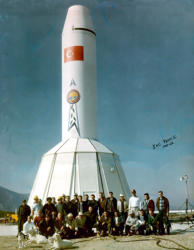
HISTORY - Page 85
Reclama to the committee findings was made by the Ordnance Corps to show that the REDSTONE was
more than just an adequate booster but offered growth potential as well. Besides, the Jet Propulsion
Laboratory (JPL) had been successful in scaling down SERGEANT motors that would provide greater specific
impulses to the upper stages than the LOKI
129
. No deviation was made by the committee from the decision.
Next, the Ordnance Corps asked that its hardware be considered for Phase II of the satellite program when
the heavier vehicles would be placed in orbit. Army R&D replied that it was not wise for the Army to apply
for such work in view of the priority programs that had been placed on Redstone Arsenal, for at that time
DOD had made the decision to develop the JUPITER
130
.
While the Army and Navy had been engaged in ORBITER planning, some engineering had been
accomplished on REDSTONE test vehicles so that these missiles were suitable to test re-entry nose cones
and launch a satellite. The death of ORBITER caused these missiles to be momentarily set aside, but the
almost immediate decision to develop JUPITER brought these vehicles to the fore again for the re-entry test
program. In fact, 12 missiles were so modified, but by the firing of the third JUPITER C re-entry test vehicle,
the nose cone problem was solved and ABMA was ready to test a full-scale JUPITER re-entry body. All during
1956 and 1957 the Army made known to authorities that the JUPITER C was able to orbit a satellite to serve
_____________________________







129. Memo, OCO to ASD (R&D), 15 Aug 55, subj: Scientific Sat Project, Hist Off files.
130. DF, COFORD to DA R&D, 8 Nov 55, subj: Scientific Sat & Cmt, DA R&D to COFORD, 8 Dec 55, same subj, Hist Off files.



Jupiter SM-78 Weapon System
I&C Team 2, Çigli AB, Turkey 1961-1962 Chrysler Corporation Missile Division

HISTORY - Page 86
Reclama to the committee findings was made by the
Ordnance Corps to show that the REDSTONE was more
than just an adequate booster but offered growth
potential as well. Besides, the Jet Propulsion
Laboratory (JPL) had been successful in scaling down
SERGEANT motors that would provide greater specific
impulses to the upper stages than the LOKI
129
. No
deviation was made by the committee from the
decision.
Next, the Ordnance Corps asked that its hardware be
considered for Phase II of the satellite program when
the heavier vehicles would be placed in orbit. Army
R&D replied that it was not wise for the Army to apply
for such work in view of the priority programs that had
been placed on Redstone Arsenal, for at that time DOD
had made the decision to develop the JUPITER
130
.
While the Army and Navy had been engaged in
ORBITER planning, some engineering had been
accomplished on REDSTONE test vehicles so that these
missiles were suitable to test re-entry nose cones and
launch a satellite. The death of ORBITER caused these
missiles to be momentarily set aside, but the almost
immediate decision to develop JUPITER brought these
vehicles to the fore again for the re-entry test
program. In fact, 12 missiles were so modified, but by
the firing of the third JUPITER C re-entry test vehicle,
the nose cone problem was solved and ABMA was
ready to test a full-scale JUPITER re-entry body. All
during 1956 and 1957 the Army made known to
authorities that the JUPITER C was able to orbit a
satellite to serve
_____________________________
129. Memo, OCO to ASD (R&D), 15 Aug 55, subj: Scientific Sat Project, Hist Off files.
130. DF, COFORD to DA R&D, 8 Nov 55, subj: Scientific Sat & Cmt, DA R&D to COFORD, 8 Dec
55, same subj, Hist Off files.





















